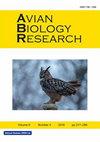Comparison of head size and bite force in two sympatric munia species
IF 1.2
4区 农林科学
Q4 AGRICULTURE, DAIRY & ANIMAL SCIENCE
引用次数: 1
Abstract
Brain size is a key factor determining the performance and fitness of an organism; birds with relatively larger brains might have advantages in the utilization of resources and dispersal. Bite force is another important indicator of fitness, and plays an essential role in intra- and inter-specific competition. In this study, a comparative analysis was conducted on the head size and bite force of the two sister species, the white-rumped munia (Lonchura striata) and scaly-breasted munia (L. punctulata) that differ in distribution range. The results showed that the scaly-breasted munia, which has a wider distribution range, had a significantly larger head size than that of the white-rumped munia. In addition, scaly-breasted munias had a greater bite force; however, the difference was not significant. One possible explanation could be that the smaller head to body ratio in scaly-breasted munias reduced their bite-force slightly. Further, this finding could be attributed to the fact that similar food resources and foraging habitats of the two species lead to a similar bite force. Our study supported the argument that head size, rather than bite force, plays a more important role in the dispersal and evolutionary adaptation of birds.两种同域文鸟头部大小和咬合力的比较
脑的大小是决定一个有机体的性能和适应性的关键因素;大脑相对较大的鸟类可能在资源利用和分散方面具有优势。咬合力是另一个重要的适应度指标,在种内和种间竞争中起着重要作用。本研究对分布范围不同的白臀文鸟(Lonchura striata)和鳞胸文鸟(L. punctulata)两个姊妹种的头部大小和咬合力进行了比较分析。结果表明,胸鳞文鸟的头大小明显大于白臀文鸟,胸鳞文鸟的分布范围更广。此外,胸鳞文鸟具有更大的咬合力;然而,差异并不显著。一种可能的解释是,胸鳞文鸟头部与身体的比例较小,这稍微降低了它们的咬合力。此外,这一发现可能归因于两个物种相似的食物资源和觅食栖息地导致了相似的咬合力。我们的研究支持了这样的观点,即头部大小,而不是咬合力,在鸟类的扩散和进化适应中起着更重要的作用。
本文章由计算机程序翻译,如有差异,请以英文原文为准。
求助全文
约1分钟内获得全文
求助全文
来源期刊

Avian Biology Research
农林科学-奶制品与动物科学
CiteScore
1.50
自引率
0.00%
发文量
17
审稿时长
2 months
期刊介绍:
Avian Biology Research provides a forum for the publication of research in every field of ornithology. It covers all aspects of pure and applied ornithology for wild or captive species as well as research that does not readily fit within the publication objectives of other ornithological journals. By considering a wide range of research fields for publication, Avian Biology Research provides a forum for people working in every field of ornithology.
 求助内容:
求助内容: 应助结果提醒方式:
应助结果提醒方式:


